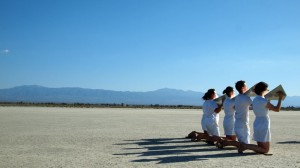Ah, summer, that time of year when research-led design turns to rocket scientists, parking lots, quantum physics and the formation of cults.

Daniel Salomon, Ingrid Hora and MDP students at a desert shoot for their "Suspension of Disbelief" project
These summer days have been far from lazy for Art Center’s Graduate Media Design Program (MDP), whose students, faculty and researchers-in-residence have been knee-deep in off-kilter research projects for the past 13 weeks. Their findings will be unveiled at “In/Conclusions: Results from the MDP Research Residencies,” tomorrow, Wednesday, August 18 at 1:30 pm in the Wind Tunnel Gallery (RSVP here).
“In/Conclusions” is just one of several events surrounding a newly-launched bi-annual program designed to identify and explore ideas that emerge from recent MDP faculty and student work. A related exhibition, Made Up, and panels, screenings and readings are also scheduled for the fall and spring, and all the activities will be captured in a publication released in Summer 2011.
For its inaugural year, MDP chose the theme Made Up, which it describes as a consideration of “the relevance of speculation, role playing, idealism, skepticism, and simple lying as instruments or objects of the design process.” This year’s researchers-in-residence—Sascha Pohflepp and duo Ingrid Hora and Daniel Salomon—were chosen by a jury made up of MDP faculty Sean Donahue and Ben Hooker; Fiona Raby, principal of design practice Dunne & Raby; and science-fiction author, WIRED columnist and former Art Center Visionary-in-Residence Bruce Sterling.
While we don’t want to give away too much before tomorrow’s event, here’s a taste of the research projects and the individuals behind them:
Sascha Pohflepp is a German-born artist and designer who regularly contributes to the Webby Award-winning blog We Make Money Not Art and whose work has been shown at London’s Victoria & Albert Museum. For his Made Up project, SUPERCALIFORNIA, Pohflepp, with assistance of MDP student Haejin Lee, is returning to territory he has explored previously—alternate reality—via Rob Walker, a fictional character inspired by Jack Parsons, a devout follower of English occultist Aleister Crowley and one of the co-founders of Pasadena’s Jet Propulsion Laboratory.
“Both of Parson’s passions aspired to some form of transcendence,” Pohflepp says of his interest in the eccentric rocket scientist. “His early rocket experiments didn’t have any goal apart from leaving the atmosphere. And with the occult, he was trying to communicate with what’s beyond.”
What can we expect from Rob Walker and SUPERCALIFORNIA? We can safely reveal that Walker is a scientist who prepared for a future that never occurred, but is determined to prepare humanity for a future yet to come. As for what the project will actually look like, clues may lie in The Golden Institute, Pohflepp’s previous alternate history project that imagined an ambitious Green energy initiative launched by President Jimmy Carter following his landslide victory against Ronald Reagan.

Cult followers engage in a sacred ritual in Daniel Salomon's and Ingrid Hora's "Suspension of Disbelief"
Italian-born artist Ingrid Hora has choreographed groups of elderly synchronized swimmers and has created furniture-like articles of clothing that allow their wearers to accomplish all manners of unusual activities, like engulfing their head in a building. Danish-born artist Daniel Salomon has given lectures on combustion in Esperanto to non-Esperanto-speaking children and created Mono, a single world currency, and the accompanying Sennacia Bank, whose first mobile branch he wheeled around himself through the streets of Berlin.
The two artists, partners in life who are now based in Berlin, are collaborating for the first time for their Made Up project Suspension of Disbelief. Throughout the term they—along with MDP students Dee Kim, Ana Ramos and Daniel Lara Saucedo—have been investigating cults in the Los Angeles region and creating a fictitious cult complete with props, specially designed devices and ready-made objects. “We see cults as symptoms of something more general about society,” says Salomon. “We’re interested in exploring why people join cults,” adds Hora. “People join because they want to be part of a group. They want to worship, confess and suffer together. It’s what we call ‘collective hope.’”
To learn more about these projects—as well as MDP Post-Graduate Fellow Hyun Ju Yang’s Participatory Universe, which focuses on quantum physics and humanity’s perception of the micro/macro universe, and Friends of Friends, a project by MDP faculty members Ben Hooker and Shona Kitchen, sponsored by Intel People and Practices Research, which explores the untapped potential of parking lots as social spaces—come to tomorrow afternoon’s event.
And stay tuned to The Dotted Line in the coming days and weeks, where we’ll bring you expanded interviews with all the researchers and their projects.










Pingback: Made Up Events Explore Design Fiction « The Dotted Line | Official Blog of Art Center College of Design | Pasadena, CA | Leading by Design